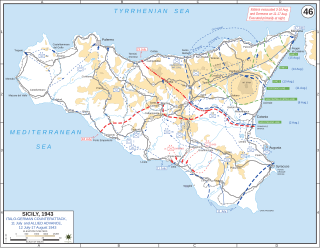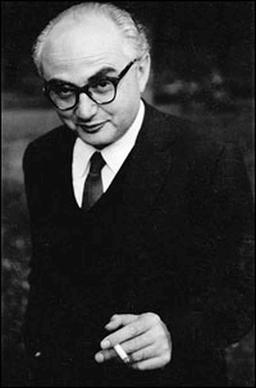
Robert Capa was a Hungarian-American war photographer and photojournalist. He is considered by some to be the greatest combat and adventure photographer in history.

The Allied invasion of Sicily, also known as the Battle of Sicily and Operation Husky, was a major campaign of World War II in which the Allied forces invaded the island of Sicily in July 1943 and took it from the Axis powers. It began with a large amphibious and airborne operation, followed by a six-week land campaign, and initiated the Italian campaign.

Salvatore Giuliano was an Italian brigand, who rose to prominence in the disorder that followed the Allied invasion of Sicily in 1943. In September of that year, Giuliano became an outlaw after shooting and killing a police officer who tried to arrest him for black market food smuggling, at a time when 70 percent of Sicily's food supply was provided by the black market. He maintained a band of subordinates for most of his career. He was a flamboyant, high-profile criminal, attacking the police at least as often as they sought him. In addition, he was a local power-broker in Sicilian politics between 1945 and 1948, including his role as a nominal colonel for the Movement for the Independence of Sicily. He and his band were held legally responsible for the Portella della Ginestra massacre, though there is some doubt about their role in the numerous deaths which occurred.

David Seymour, or Chim, was a Polish photographer and photojournalist.

War photography involves photographing armed conflict and its effects on people and places. Photographers who participate in this genre may find themselves placed in harm's way, and are sometimes killed trying to get their pictures out of the war arena.

40 Squadron SAAF existed as a combat unit from early 1940 through to late 1945. It served in the East African Campaign, Western Desert, Tunisia, and Italy, reaching Austria by the end of World War II. The squadron's motto in those years was Amethlo e Impi – "the eyes of the army".

Gerta Pohorylle, known professionally as Gerda Taro, was a German war photographer active during the Spanish Civil War. She is regarded as the first female photojournalist to have died while covering the frontline in a war.

Cornell Capa was a Hungarian-American photographer, member of Magnum Photos, photo curator, and the younger brother of photo-journalist and war photographer Robert Capa. Graduating from Imre Madách Gymnasium in Budapest, he initially intended to study medicine, but instead joined his brother in Paris to pursue photography. Cornell was an ambitious photo enthusiast who founded the International Center of Photography in New York in 1974 with help from Micha Bar-Am after a stint of working for both Life magazine and Magnum Photos.

The Battle of Troina was an important battle that took place between 31 July and 6 August 1943, as part of the Allied invasion of Sicily during World War II. Forces of the U.S. II Corps, part of the U.S. Seventh Army, under George S. Patton, engaged in fierce fighting around the town of Troina in the central portion of Sicily along the Caronie Mountains. The battle focused around the numerous hills and mountains surrounding Troina which the Germans had heavily fortified and used as bases for direct and indirect fire.

Calogero Vizzini, also commonly known as "Don Calò", was a Sicilian Mafia boss of Villalba in the province of Caltanissetta, Sicily. He was considered to be one of the most influential and legendary Mafia bosses of Sicily after World War II until his death in 1954. In the media, Don Calò was often depicted as the "boss of bosses" – although such a position does not exist in the loose structure of Cosa Nostra.

Troina is a comune (municipality) in the province of Enna, in the Italian region of Sicily. It is located in the Nebrodi Park. It is one of I Borghi più belli d'Italia.
Operation Underworld was the United States government's code name for its co-operation with the Italian-American Mafia and Jewish organized-crime figures from 1942 to 1945. The operation aimed to counter Axis spies and saboteurs along the U.S. northeastern seaboard ports, to avoid wartime labor-union strikes, and to limit theft by black marketeers of vital war supplies and equipment.

The Falling Soldier is a black and white photograph by Robert Capa, claimed to have been taken on Saturday, September 5, 1936. It was said to depict the death of a Republican soldier from the Libertarian Youth (FIJL) during the Battle of Cerro Muriano of the Spanish Civil War. The soldier in the photograph was later claimed to be the anarchist militiaman Federico Borrell García.

Letizia Battaglia was an Italian photographer and photojournalist. Although her photos document a wide spectrum of Sicilian life, she is best known for her work on the Mafia.

The Magnificent Eleven are a group of photos of D-Day taken by war photographer Robert Capa. Capa was with one of the earliest waves of troops landing on the American invasion beach, Omaha Beach. Capa stated that while under fire, he took 106 pictures, all but eleven of which were destroyed in a processing accident in the Life magazine photo lab in London, although the accidental loss of the remaining negatives has been disputed. The surviving photos have since been called the Magnificent Eleven. The pictures have been widely celebrated, and Steven Spielberg is said to have been inspired by them when filming Saving Private Ryan.

15th Panzergrenadier Division was a mobile division of the German Army in World War II.

The Battle of Cerami was fought in June 1063 and was one of the most significant battles in the Norman conquest of Sicily, 1060–1091. The battle was fought between a Norman expeditionary force and a Muslim alliance of Sicilian and Zirid troops. The Normans fought under the command of Roger de Hauteville, the youngest son of Tancred of Hauteville and brother of Robert Guiscard. The Muslim alliance consisted of the native Sicilian Muslims under the Kalbid ruling class of Palermo, led by Ibn al-Hawas, and Zirid reinforcements from North Africa led by the two princes, Ayyub and 'Ali. The battle was a resounding Norman victory that utterly routed the opposing force, causing divisions amongst the Muslim aristocracy which ultimately paved the way for the eventual capture of the Sicilian capital, Palermo, by the Normans and subsequently the rest of the island.

Charles Thompson Horner Jr. was a highly decorated officer of the United States Army who served in the 16th Infantry Regiment, U.S. 1st Infantry Division from July 1940 to February 1946 and held every position from Platoon Leader to Regimental Commander. As a leader in the "Big Red One", he participated in the North Africa, Sicily, and the European Campaigns and three amphibious landings; the invasions of North Africa, Sicily, and Europe where he commanded the 3rd Battalion, 16th Infantry on Omaha Beach.
At War with Love is a 2016 Italian comedy film directed by Pif.

The Picture of the Last Man to Die is a black and white photograph taken by Robert Capa during the battle for Leipzig, depicting an American soldier, Raymond J. Bowman, aged 21 years old, after being killed by a German sniper, on 18 April 1945, shortly before the end of World War II in Europe. Germany would surrender two weeks later following the Battle of Berlin.


















